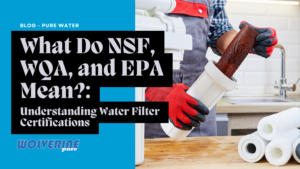News of PFAS contamination has been seeping into local headlines more and more over the past few years, especially in Michigan. But as scientists and researchers uncover more data about PFAS and their adverse health effects, the questions facing everyday consumers become more and more murky. The first step to protecting your family from PFAS is understanding what they are, where they come from, how they affect our bodies, how they get into our homes and — most importantly — what you can do about it.
What are PFAS?
Per- and polyfluoroalkyl substances (PFAS) are a group of man-made chemicals that includes PFOA, PFOS, GenX, and many others. They are used in a variety of materials, including in fire fighting foam, in stain-, grease-, and water-repellent items, in some food packaging, and in many other common products. Here’s a comprehensive list of products that may contain PFAS.
While people can be exposed to PFAS through everyday use of products or if they work in a manufacturing plant with those products, the most common route of exposure is through contaminated drinking water. PFAS can seep into the groundwater around manufacturing plants or industrial facilities where the chemicals are utilized, or around oil refineries, airfields or other locations where PFAS are used for firefighting. This groundwater contamination can make its way into the local water system, contaminating community tap water at various levels.
Michigan has made headlines for its high number of PFAS contamination sites. But the state has ramped up contamination site testing and mitigation efforts to help protect Michigan residents.
Are PFAS dangerous?
According to the Agency for Toxic Substances and Disease Registry, “most people in the United States have been exposed to PFAS and have PFAS in their blood, especially perfluorooctane sulfonic acid (PFOS) and perfluorooctanoic acid (PFOA).” If PFAS are such a widespread issue, how dangerous are they to humans?
PFAS are sometimes referred to as “forever chemicals” or “zombie chemicals.” Their unique chemical makeup prevents them from breaking down under typical environmental conditions, which means they can take hundreds or thousands of years to break down, whether they’re found in soil, water, or the human body. As people are exposed to PFAS from a variety of sources over time, the level of PFAS in their bodies may increase to the point where they suffer from adverse health effects, such as low birth weights in infants, increasing cholesterol levels, fertilization issues in women, and increased risks of certain cancers. Here’s a fuller look at the adverse health effects associated with PFAS.
The federal government does not currently regulate PFAS, though the Environmental Protection Agency (EPA) does provide a recommendation to states and has made progress on gathering necessary data and establishing new standards. There is no agreed-upon “safe” or enforceable limit of PFAS in drinking water supplies, so each state is left to set their own standards. Michigan follows the EPA’s lifetime health advisory (LTHA) level for two PFAS commonly found in drinking water: 70 parts per trillion (ppt) [source] for PFOA and PFOS combined.
How do you treat PFAS?
Unless you receive a specific warning from your municipal water provider, it can be challenging to tell if PFAS is affecting your home’s water supply. Most commercial or consumer water tests cannot detect PFAS contaminants. There are a select number of private labs who can conduct thorough PFAS testing, but it can be costly for consumers and very challenging to avoid cross contamination. PFAS are used in many products, meaning it’s very easy for traces of PFAS to enter your home’s sample at any point along its journey from your faucet to the lab.
While it may be challenging to know how PFAS is affecting your home, you can take steps to treat or block PFAS contamination in your home. According to the Environmental Working Group, a public health advocacy organization, “the most effective choice for in-home treatment of PFAS-tainted tap water is a reverse osmosis filter, followed by an activated carbon filter.” Whole-home water filtrations systems, such as a Wolverine Water Blue Line Water Treatment System with Whole House Filters to filter and contain PFAS, along with a Wolverine Water Reverse Osmosis System with Alkaline filtration, would treat your water to a undetectable quantity of PFAS contamination.
As of right now, these types of filters are the only way to remove PFAS from your home’s water supply. Common water filter pitchers cannot remove PFAS from your home’s drinking water, and it’s up to individual municipalities to invest in costly, high maintenance filters that can serve entire drinking water supplies and remove PFAS from tap water.
At Wolverine Water, the health and safety of the communities we serve is our highest priority. If you have any questions or concerns about PFAS in your drinking water, call our office today at 517.339.0722. We will do our best to answer your questions and discuss whole-home water filtration options that may work for you.




